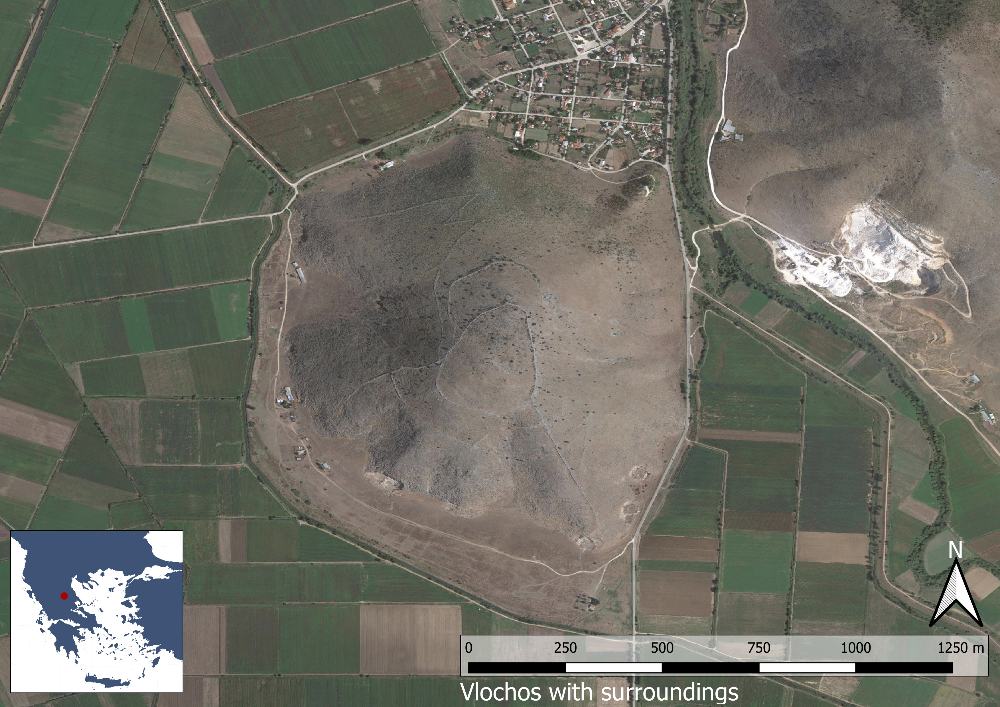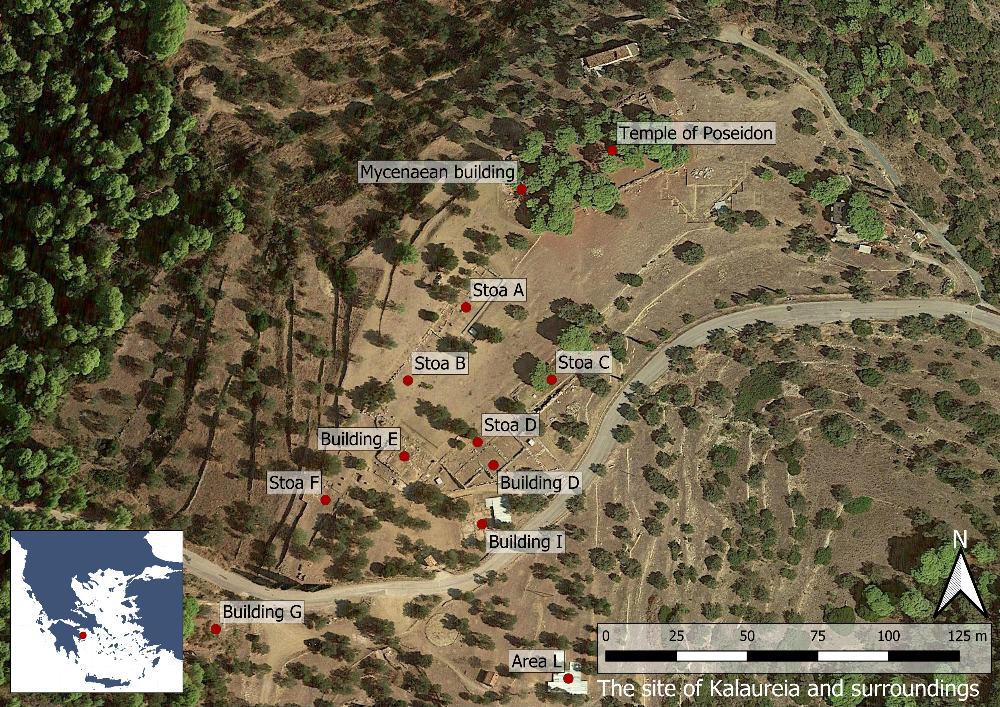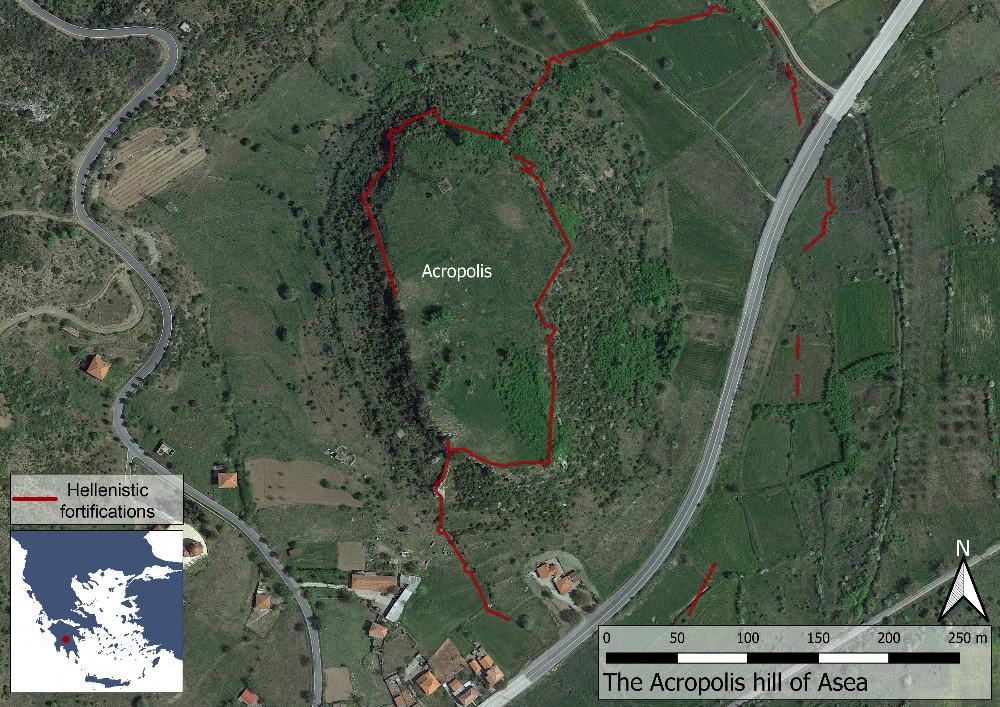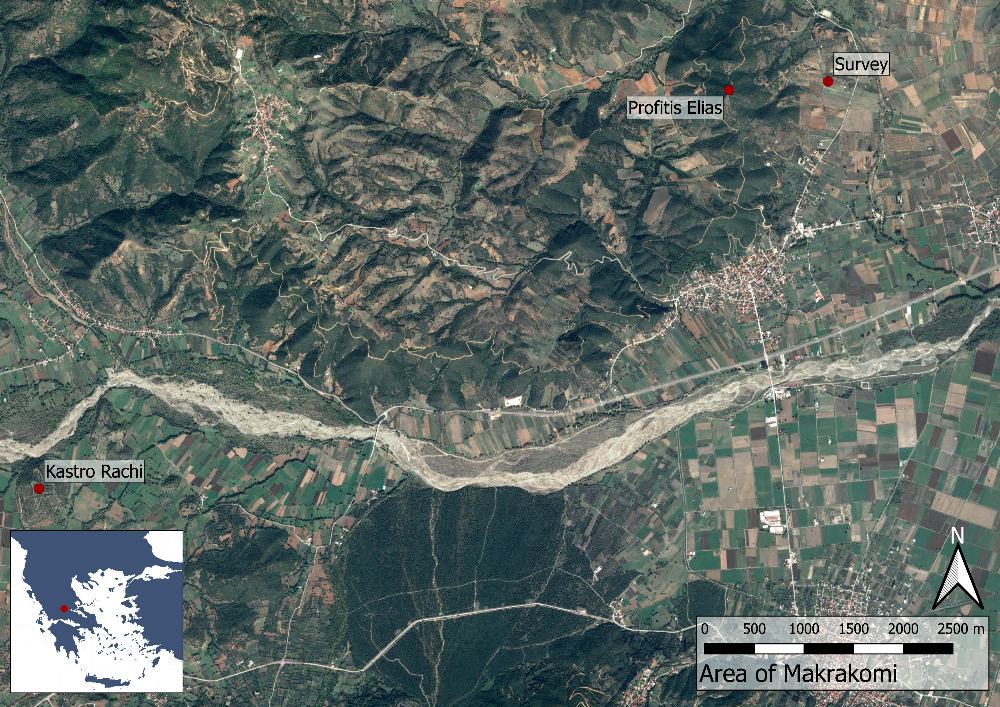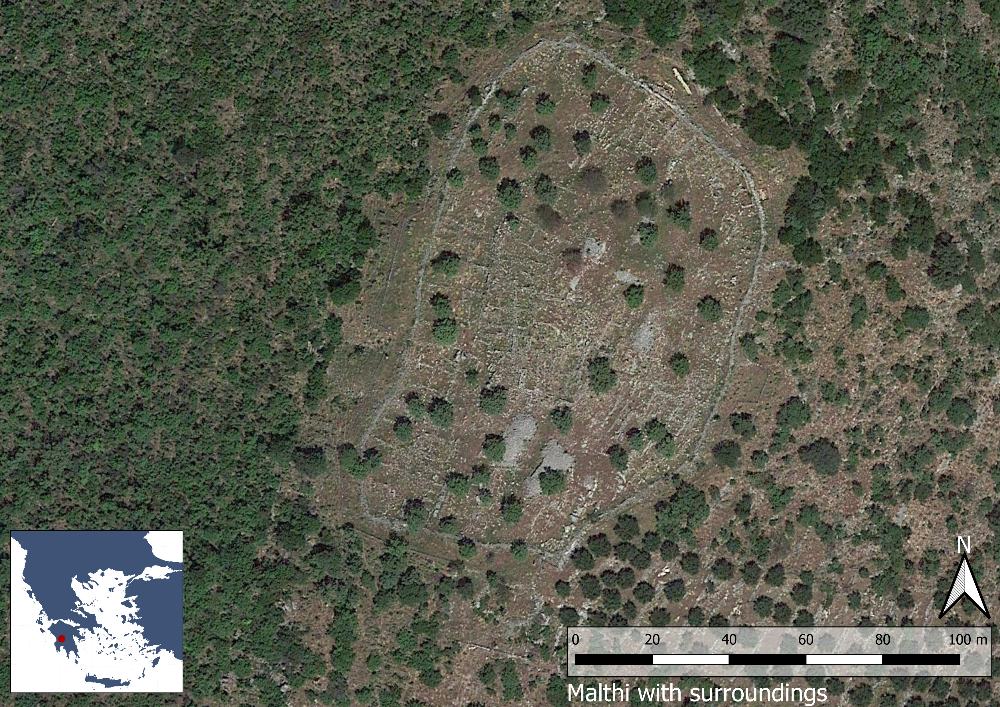Midea, Argolid (1939, 1963, 1983–2009)
Published: 2020-05-18
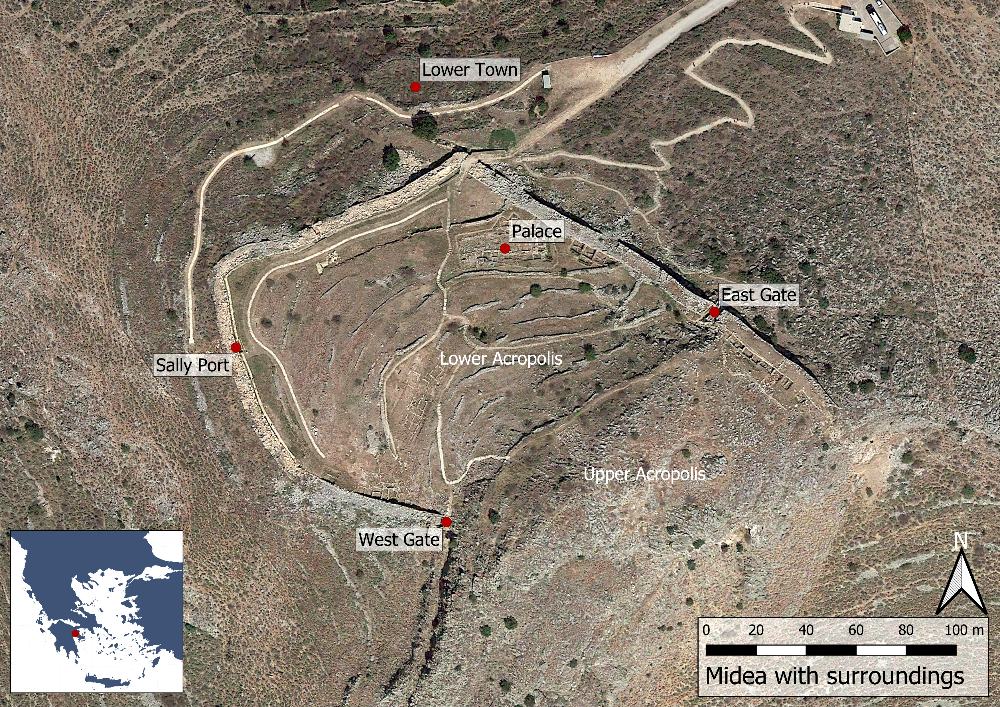
Fig. 1: Map over the site of Midea (Basemap: Google maps satellite image).
The acropolis of Midea and its important Late Bronze Age citadel is located on a 270 m tall conical hill in the Argolid, 1.5 km from the contemporary cemetery at Dendra and about midway between Tiryns and Mycenae. From the top of the hill, looking south and west the site offers a magnificent view of the Argive plain and gulf. To the north and east the tall inland mountains dominate the landscape. This view, making it possible to monitor the plain and its approaches, possibly contributed to the importance of the site during the Bronze Age.
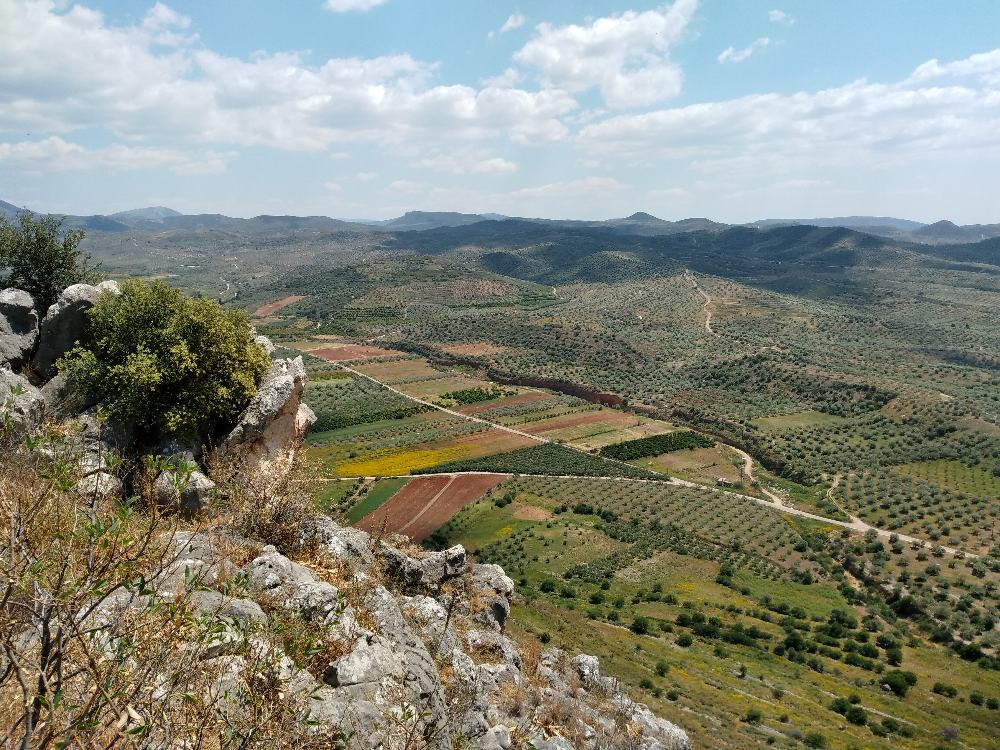
Fig. 2: View from Midea towards the inland mountains.
Excavation history
Already nineteenth century travellers, such as Leake, Gell and Curtius, noted the massive walls of Midea, which are still clearly visible from the plain below. The identity of the site was established using the testimonies of Pausanias (2.25.9) and Strabo (8.6.11). The first investigations at the site took place in 1907 when German archaeologists opened small trial trenches, however without uncovering any buildings. In 1939, following his work at nearby Dendra, the Swedish scholar Axel. W. Persson concluded that Midea was a fortified Mycanean citadel and recorded the line of the walls, cleaned the East Gate area and opened several trenches in the Lower Acropolis and at the summit. After the war, Paul Åström and his Greek colleague Nikolaos Verdelis resumed work at the site in 1963, excavating a small area close to the East Gate. In 1983 systematic explorations of Midea commenced through a joint Greek-Swedish excavation project under the direction of the Ephor Katie Demakopoulou and Paul Åström. Work focused on the area within the citadel wall and the two gate areas in particular. In general, the Lower Acropolis is considerably better understood than the Upper, where severe erosion has removed most remains. Since 2000 the Swedish part of the project is directed by Ann-Louise Schallin.
Site and remains
The earliest material found at Midea consist of pottery from the Middle and Final Neolithic periods (c. 5800–3100 BC). All Bronze Age periods are represented, with the most impressive remains dating to the end of the period. During this time, most of the buildings at Midea were decorated with painted frescos, as attested by abundant fragments. This suggests that the site hosted a wealthy society.
During the Early Helladic period (c. 3100–2000 BC) only the Upper Acropolis was inhabited. Work near the summit has revealed two terrace walls, one to the north-east and one to the north-west. At the latter, Late and Final Neolithic pottery was found, as well as Early and Middle Helladic (c. 3100–1600 BC) tombs and structures, including remains of a defensive system. During the Middle Helladic period (c. 2000–1600 BC) the settlement expanded to include a larger part of the site. In addition to these early remains, Persson believed the summit to be the site of a Megaron. He recorded cuttings in the bedrock during the 1939 campaign and created a preliminary plan of a ‘palace’ based on those traces. His observations are difficult to verify today because of the erosion of the bedrock and the dense vegetation covering the plateau.
During the Late Bronze Age large-scale construction took place at Midea. Around 1200 BC an impressive fortification wall, 450 m long, 5–7 m wide and 7 m tall, was constructed, encircling the north, west and south sides of the site, while the east was protected by the steep cliff face. In total the citadel encompasses an area of 2.4 ha. Two gates (called the East and West gates) allowed access to the citadel. In addition to this, a sally port was located close to the west end of the site.

Fig. 3: The fortifications of Midea.
Both the East and West gates were monumental structures. The former was the main entrance to the acropolis, accessed by a large cyclopean ramp. The West Gate was constructed by the fortification wall on the west side and cut into the living rock of the Upper Acropolis to the east. The wide entranceway was provided with a guardroom, located in the wall, as well as a massive bastion protecting the outer face. The much smaller sally port consisted of a thin covered passageway running slightly obliquely through the 5.70 m thick wall. At some point in time this exit was blocked and the outer face of the wall repaired in a different masonry style.
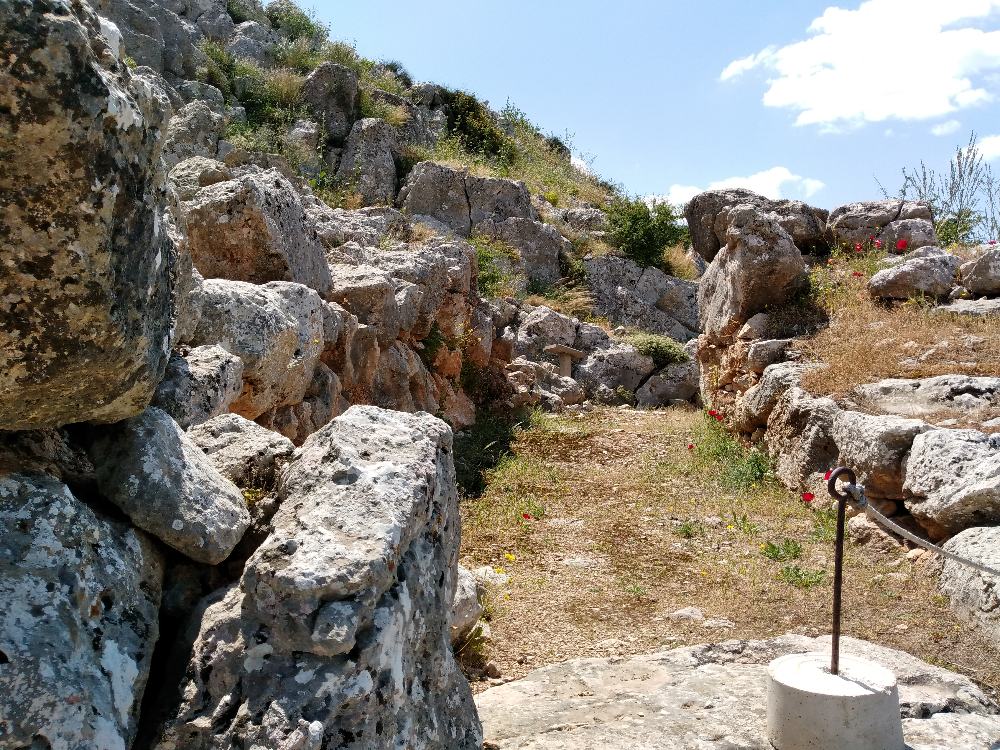
Fig. 4: The West Gate from inside the citadel.
Remains of various buildings have been found inside the fortifications. Just east of the East Gate a number of basement rooms were attached to the inner face of the wall. The many large vessels found here suggest that the rooms were used for storage. In addition, the excavations revealed many fragments of decorated fine-ware pottery, jewellery, ivory inlays, tools and remains of raw material in the area. This indicates that the basements had upper floors, in which workshops were located.
A similar complex of 14 rooms, divided into two wings, has been identified inside the West Gate, where fragments of pithoi and other storage vessels, stone mortars as well as stone, bronze and bone tools were found. Terracotta figurines, seal-stones, jewellery and semi-precious stones were also discovered. Most importantly, a nodule (a clay lump covering the knot sealing a vessel) with the Linear B word for wheat testifies to the storage of grain here. Similarly, a storage jar inscribed with wi-na-jo, a Cretan name attested also at Knossos and Armenoi, indicates that Midea was part of the large-scale trade network in existence at the end of the Bronze Age.
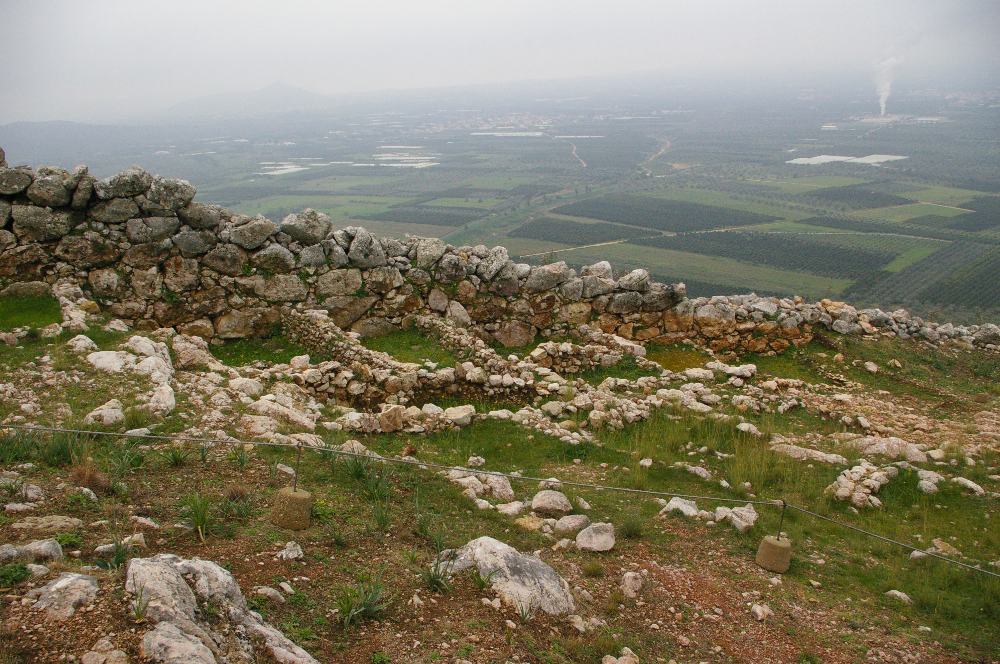
Fig. 5: Storage rooms close to the West Gate.
The most important structure inside the fortifications, however, was the Megaron. It dates to LH IIIB2 (late 13th century BC) and conforms to the standard type with four columns surrounding a great hearth. Finds such as sword pommels of precious materials, cult vessels and a faience necklace reflect the status of the structure. One of the most important finds was a nodule impressed with a seal depicting a lion attacking a bovid, and the text contribution to the megaron from Aisonios (the name of an individual). Notably, the seal dates to LH IIIA (c. 1390–1300 BC), while the nodule was found in a LH IIIB2 (late 13th century BC) context. It is therefore possible that the seal itself was an heirloom, used over a long period of time. Around 1200 BC the Megaron was destroyed with the rest of the settlement. It was then replaced by a smaller version during LH IIIC Early (early 12th century BC), something which closely reflects the development in nearby Tiryns.
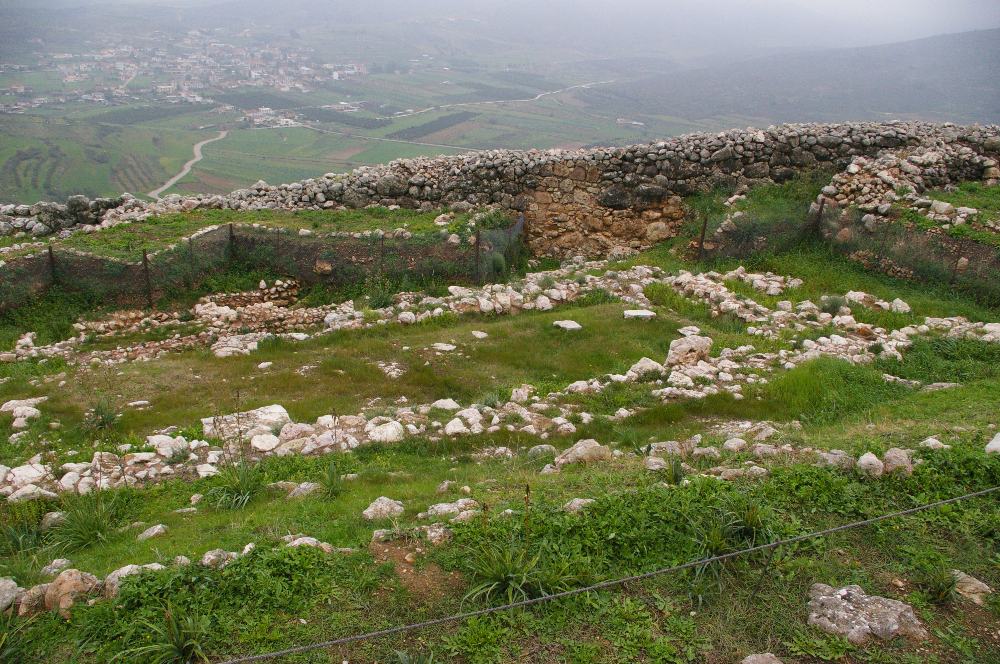
Fig. 6: The Megaron at Midea.
A Lower Town likely existed outside of the fortifications, in addition to the habitation in the citadel. While not yet securely identified, a large terrace wall and other structural remains suggest that it was located to the north-west.
At the end of the Late Bronze Age and shortly after the construction of the massive walls, around 1200 BC, Midea was destroyed. The destruction layer is characterized by ashy, grey soil, mixed with bits and pieces of charcoal and other burnt organic material. The cause behind the destruction is unknown, but tilted and curved walls, as well as remains of humans crushed under stones and boulders suggest that it was the result of an earthquake followed by conflagration. Some scholars, however, have connected the end of Midea to hostile forces attacking the site.
After the Bronze Age only limited activity can be noted at Midea. A single sherd and a bronze disk from the Geometric period have been found. Some Archaic material suggests human activity at the site, although no settlement has of yet been located. A fragment of an architectural terracotta from this period may indicate that a sanctuary or settlement existed in the vicinity of the citadel. According to Pausanias (8.27.1) whatever population remained at Midea was forced moved to Argos, presumably in the beginning of the 5th century BC. In the early 1st century AD Strabo (8.6.11) wrote that Midea was deserted. This is significant as he often notes that other pre-historic sites had shrunk to villages, but had not been abandoned. Similarly, Pausanias (2.25.9) wrote in the mid-2nd century AD that nothing but the foundations of Midea remained.
The hiatus ends around 500 AD when the Lower Acropolis was re-occupied. Two Late Roman structures, presumably houses, have been found in the area of the Late Bronze Age Megaron. Possibly, this new habitation was prompted by Slavic invasions that ravaged the area at the time, destroying for example nearby Nemea. Among other finds, such as pottery and Late Roman coins, three skeletons were found within the small settlement. One of these was discovered under the floor of a building, suggesting that the death of the individual was not associated with the abandonment of the site, which took place in the 6th century AD. The same area was then resettled again for a generation or two around 1200 AD when the Late Roman structures were reused and expanded. During this period the population probably consisted of small-scale cultivators. Several deep pits testify to large scale efforts to clear the Lower Acropolis at this time. Possibly, these were dug in order to clear the area for agriculture, or to prepare the site for the construction of a kastro which was never built.
Bibliography
Åström, P. 1964. ‘Excavations in the Citadel of Midea 1963’, ArchDelt 19, 134.
Åström, P. 2009. ‘Foundation trenches for the Citadel wall of Midea’, in Δώρον: τιμητικός τομός για τον καθηγητή Σπύρο Ιακωβίδη (Σειρά Μονογραφιών, 6), ed. Δ. Δανιηλίδου, Αθήνα, 67– 71.
Åström, P. & K. Demakopoulou 1986. ‘New Excavations in the Citadel of Midea, 1983–1984’, OpAth 16, 19–25.
Åström, P., K. Demakopoulou, N. Divari-Valakou & G. Walberg 1990. ‘Excavations in Midea 1987’, OpAth 18, 9–22.
Demakopoulou, K. 1998. ‘Stone vases from Midea’, in The Aegean and the Orient in the second millennium: proceedings of the 50th Anniversary Symposium, Cincinnati, 18–20 April 1997. Aegaeum 18, eds. H.E. Cline & D. Harris-Cline, Liège, 221–227.
Demakopoulou, K. 1999. ‘A Mycenaean terracotta figure from Midea in the Argolid’, in Meletemata: studies in Aegean archaeology presented to Malcolm H. Wiener as he enters his 65th year. Vol. I., eds. P.P. Betancourt, V. Karageorghis, R. Laffineur & W.-D. Niemeier, Liège, 197–205.
Demakopoulou, K. 2003. ‘The pottery from the destruction layers at Midea: Late Helladic IIIB2 Late or Transitional Late Helladic IIIB2/Late Helladic IIIC Early? LH III C chronology and synchronisms’, in Proceedings of the International Workshop Held at the Austrian Academy of Sciences at Vienna May 7th and 8th, 2001, eds. S. Deger-Jalkotzy & M. Zavadil, Wien, 77–92.
Demakopoulou, K. 2006. ‘Mycenaean pictorial pottery from Midea’, in Pictorial pursuits: figurative painting on Mycenaean and Geometric pottery. Papers from two seminars at the Swedish Insititute at Athens in 1999 and 2001 (ActaAth 4˚, 53), eds. E. Rystedt & B. Wells, Stockholm, 31–43.
Demakopoulou, K. 2007. ‘The role of Midea in the network of Mycenaean citadels in the Argolid’, in Keimelion: Elitenbildung und Elitärer Konsum von der Mykenischen Palastzeit bis zur Homerischen Epoche. The Formation of Elites and Elitist Lifestyles from Mycenaean Palatial Times to the Homeric Period. Akten des internationalen Kongresses vom 3. bis 5. Februar 2005 in Salzburg (Veröffentlichungen der Mykenischen Kommission, 27; Österreichische Akademie der Wissenschaften Philosophisch-Historische Klasse Denkschriften, 350), eds. E. Alram-Stern & G. Nightingale, Wien, 65–80.
Demakopoulou, K. 2015. ‘The Mycenaean Acropolis of Midea: new discoveries and new interpretations’, in Mycenaeans up to date: the archaeology of the north-eastern Peloponnese - current concepts and new directions (ActaAth 4°, 56), eds. A.-L. Schallin & I. Tournavitou, Stockholm, 185–196.
Demakopoulou, K. & N. Divari-Valakou 1993. ‘A Linear B inscribed stirrup jar from Midea (MI Z 2)’, Minos 27–28, 303–305.
Demakopoulou, K. & N. Divari-Valakou 1997. ’New finds with Linear B inscriptions from Midea’, Minos 29–30 (1994–1995), 323–328.
Demakopoulou, K. & N. Divari-Valakou 1999. ‘The fortifications of the Mycenaean Acropolis of Midea’, in POLEMOS: le contexte guerrier en Égée á lʼâge du Bronze. Actes de la 7e Rencontre égéenne internationale Université de Liège, 14-17 avril 1998. Aegaeum: Annales dʼarchéologie égéenne de lʼUniversité de Liège et UT-PASP 19, ed. Robert Laffineur, Liège, 205–215.
Demakopoulou, K. & N. Divari-Valakou 2000. ‘Evidence for cult practice at Midea: figures, figurines and ritual objects’, JPR 14, 18–19.
Demakopoulou, K. & N. Divari-Valakou 2001. ‘Evidence for cult practice at Midea: figures, figurines and ritual objects’, in Potnia: deities and religion in the Aegean Bronze Age. Proceedings of the 8th International Aegean Conference / 8e Rencontre égéenne internationale. Göteborg, Göteborg University, 12-15 April 2000, eds. R. Laffineur & R. Hägg, Liège, 181–190.
Demakopoulou, K. & N. Divari-Valakou 2009. ‘Mycenaean figures and figurines from Midea’ in Encounters with Mycenaean figures and figurines: Papers presented at a seminar at the Swedish Institute at Athens, 27-29 April 2001 (ActaAth 8º, 20), ed. A.-L. Schallin, Stockholm, 37–53.
Demakopoulou, K. & N. Divari-Valakou 2010. ‘The Middle Helladic settlement on the Acropolis of Midea’, in Mesohelladika. Μεσοελλαδικά: La Grèce continentale au Bronze Moyen. Η ηπειρωτική Ελλάδα στη Μέση εποχή του Χαλκού. The Greek Mainland in the Middle Bronze Age. Actes du colloque international organisé par lʼÉcole française dʼAthènes, en collaboration avec lʼAmerican School of Classical Studies at Athens et le Netherlands Institute in Athens, Athènes, 8-12 mars 2006 (BCH Suppl., 52), eds. A. Philippa-Touchais, , G. Touchais, S. Voutsaki & J. Wright, Athènes, 31–44.
Demakopoulou, K., N. Divari-Valakou, P. Åström & G. Walberg 1997. ‘Excavations in Midea 1994’, OpAth 21, 13–32.
Demakopoulou, K., N. Divari-Valakou, P. Åström & G.Walberg 1997–1998. ‘Excavations in Midea 1995–1996’, OpAth 22–23, 57–90.
Demakopoulou, K., N. Divari-Valakou, P. Åström & G. Walberg 2000–2001. ‘Work in Midea 1997–1999: excavation, conservation, restoration’, OpAth 25–26, 35–52.
Demakopoulou, K., N. Divari-Valakou, M. Lowe Fri, M. Miller, M. Nilsson & A.-L. Schallin 2010. ‘Excavations in Midea 2008–2009, OpAthRom 3, 7–32.
Demakopoulou, K., N. Divari-Valakou, J. Maran, H. Mommsen, S. Prillwitz & G. Walberg 2017. ‘Clay paste characterization and provenance determination of Middle and Late Helladic vessels from Midea’, Opuscula 10, 7–49.
Demakopoulou, K., N. Divari-Valakou, M. Nilsson & A.-L. Schallin 2006–2007. ‘Excavations in Midea 2005’, OpAth 31–32, 7–29.
Demakopoulou, K., N. Divari-Valakou, M. Nilsson & A.-L. Schallin 2008. ‘Excavations in Midea 2006’, OpAthRom 1, 7–30.
Demakopoulou, K., N. Divari-Valakou, M. Nilsson & A.-L. Schallin 2009. ‘Excavations in Midea 2007’, OpAthRom 2, 7-30.
Demakopoulou, K., N. Divari-Valakou & A.-L. Schallin 2003. ‘Excavations in Midea 2002’, OpAth 28, 7–28.
Demakopoulou, K., N. Divari-Valakou, A.-L. Schallin, G. Ekroth, A. Lindblom, M. Nilsson, & L. Sjögren 2002. ‘Excavations in Midea 2000 and 2001’, OpAth 27, 27–58, 38–39.
Demakopoulou, K., N. Divari-Valakou, A.-L. Schallin, L. Sjögren & M. Nilsson 2005. ‘Excavations in Midea 2004’, OpAth 30, 7–34.
Demakopoulou, K., N. Divari-Valakou, A.-L. Schallin, E. Weiberg, L. Sjögren & M. Nilsson 2004. ‘Excavations in Midea 2003’, OpAth 29, 9–27.
Demakopoulou, K., N. Divari-Valakou & G. Walberg 1994. ‘Excavations and restoration work in Midea 1990–1992’, OpAth 20, 19–41.
Demakopoulou, K., I. Fappas, E. Andersson Strand, M.-L. Nosch & J. Cutler 2015. ‘Textile tools from Midea, mainland Greece’, in Tools, textiles and contexts: investigating textile production in the Aegean and Eastern Mediterranean Bronze Age (Ancient Textiles Series, 21), eds. E. Andersson Strand & M.-L. Nosch, Oxford & Philadelphia, 247–252.
Kosmetatou, E. 1997. ‘Midea in the Post-Bronze-Age period: a preliminary report’, OpAth 21, 115–123.
Margaritis, E., K. Demakopoulou & A.-L. Schallin 2014. ‘The archaeobotanical samples from Midea: agricultural choices in the Mycenaean Argolid’, in Physis: lʼenvironnement naturel et la relation homme-milieu dans le monde égéen protohistorique. Actes de la 14e Rencontre égéenne internationale, Paris, Institut National dʼHistoire de lʼArt (INHA), 11-14 décembre 2012 (Aegaeum, 37), eds. G. Touchais, R. Laffineur & F. Rougemont, Leuven & Liege, 271–277.
McMullen Fisher, S. & L.K. Giering 1994. ‘A pictorial stirrup jar from the Mycenaean Citadel of Midea’, JPR 8, 8–20.
Persson, A.W. 1942. New tombs at Dendra near Midea (Skrifter utgivna av Kungl. Humanisktiska Vetenskapssamfundet i Lund, 34), Lund.
Sabatini, S. 2016. ‘Textile tools from the East Gate at Mycenaean Midea, Argolis, Greece’. OpAthRom 9, 217–247.
Schallin, A.-L. 2012. ‘Mycenaean jewellery and adornment at Midea’, in Kosmos: jewellery, adornment and textiles in the Aegean Bronze Age. Proceedings of the 13th International Aegean Conference/13e Rencontre égéenne internationale, University of Copenhagen, Danish National Research Foundationʼs Centre for Textile Research, 21–26 April 2010 (Aegaeum, 33), M.-L. Nosch & R. Laffineur, Leuven & Liege, 509–513.
Schallin, A.-L. 2016. ‘Identities and ‘precious’ commodities at Midea and Dendra in the Mycenaean Argolid’, in Local and global perspectives on mobility in the Eastern Mediterranean (Papers and Monographs from the Norwegian Institute at Athens, 5), ed. O.C. Aslaksen, Athens, 159–190.
Walberg, G. 1992. ‘A Linear B Inscription from Midea’, Kadmos 31, 93.
Walberg, G. 1998. Excavations on the Acropolis of Midea: results of the Greek-Swedish excavations under the direction of Katie Demakopoulou and Paul Åström. Volume I. The excavations on the Lower Terraces 1985–1991(ActaAth 49:1), Stockholm.
Walberg, G. 2007. Midea: The Megaron Complex and Shrine Area. Excavations on the Lower Terraces 1994–1997 (Prehistoric Monographs, 20), Philadelphia.
Walberg, G. & D.S. Reese 2008. ‘Feasting at Midea’, in Dais: the Aegean feast. Proceedings of the 12th International Aegean Conference / 12e Rencontre égéenne internationale, University of Melbourne, Centre for Classics and Archaeology, 25-29 March 2008 (Aegaeum, 29), eds. L.A. Hitchcock, R. Laffineur & J. Crowley, Liège & Austin, 239–245.


